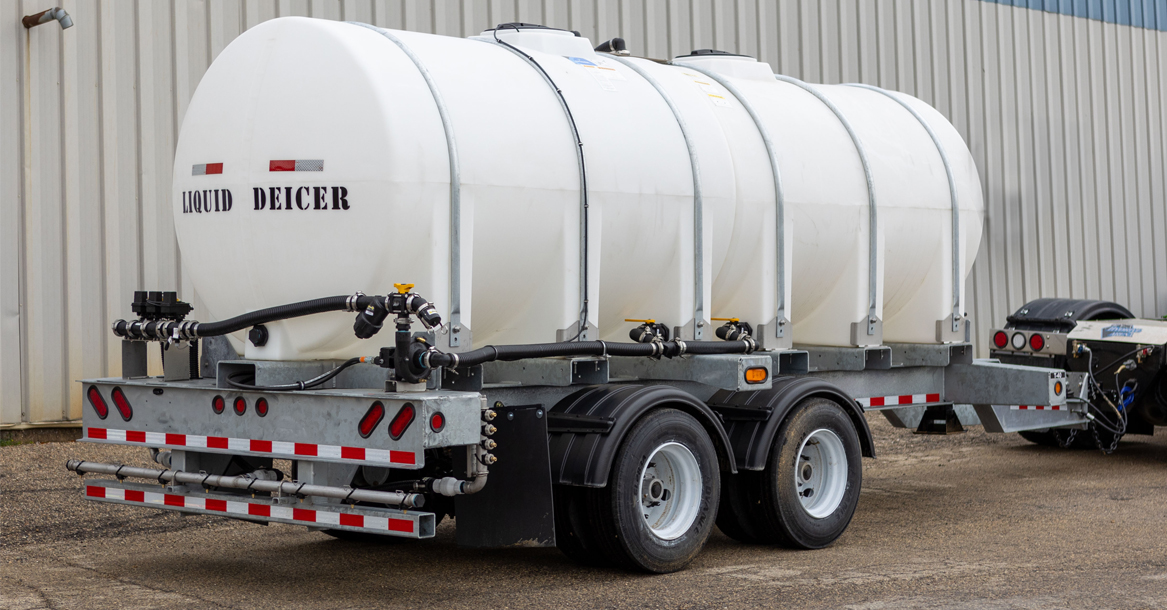If you’ve seen the white streaks of solution on roads when snow or ice is in the forecast, you’re probably looking at liquid brine. Since the nineties many parts of the U.S. have transitioned to spraying liquid salt instead of just spreading traditional rock salt and sand. But why the switch? It’s time liquid brine gets the recognition it deserves for being an effective “ice-fighter.”
The Logic of Liquid
Spraying liquid brine to fight ice and snow is designed to optimize the use of salt while reducing the environmental impact of traditional rock salt. When dry salt is spread on roads, much of it is either blown off by wind or displaced by traffic. The overuse of rock salt results in wasted resources, higher costs, and a less effective ice-fighting solution. Liquid brine, however, stays where it’s sprayed and does the job efficiently.
The Advantages of Spraying Brine
Accurate Application: Unlike rock salt, which can bounce or be displaced by traffic, liquid brine stays put, ensuring a more targeted application.
Environmentally Friendly: Since 75% of liquid brine is water, is better for your gardens, grass, and the environment compared to traditional rock salt because it reduces runoff that could harm plants or pollute nearby water.
Cost Savings: Because less salt is needed, the use of liquid brine can significantly reduce costs—some reports indicate up to 64% savings in de-icing expenditures.
More Effective: Liquid brine works at much lower temperatures than rock salt—down to -45°F, while rock salt is typically ineffective below 10°F.
Larger Pre-treatment Window: Liquid brine solutions can be applied 24 to 48 hours before a snowstorm and start working immediately, unlike rock salt which requires moisture to begin working.
A Preventative Solution
Weather, as we all know, is very unpredictable. Local road crews often face variables such as traffic patterns, mechanical issues, and staffing shortages, making it challenging to keep roads clear during a storm. Brine is often applied as a pre-treatment before a winter storm to create a barrier on road surfaces, preventing the adhesion of snow and ice. This allows crews to be proactively clearing roads before the snow event even begins.
Brine to the Rescue: Before, During, and After
Before: Liquid brine can be applied up to 48 hours before snow or ice is expected. It helps prevent snow and ice from bonding to the pavement, making it easier for plows to clear roads. In some cases, it can even prevent accumulation altogether.
During: During extended weather events or heavy precipitation, liquid brine works wonders in preventing ice from forming, especially when rain turns to sleet or freezing rain. It sticks to icy surfaces immediately, preventing further ice buildup, something rock salt struggles to do, especially in cold temperatures.
After: Once snow has settled, and plows have cleared the bulk of it, liquid brine is still essential. In frigid temperatures, residual snow and ice can quickly turn into a slippery glaze, creating dangerous conditions. Liquid de-icing helps to mitigate this, ensuring safer roads.
Ice Ain’t Nice
There are many ways to fight snow and ice, and traditional rock salt and sand remain crucial tools for many weather scenarios. However, liquid de-icing has proven itself to be a high-performance alternative to rock salt. It’s worth noting that while liquid deicing solutions have a steeper learning curve—requiring careful mixtures to ensure effectiveness in different conditions—and a more complex setup for spraying, the long-term cost savings and effectiveness make it an attractive option.
Spraying liquid brine is here to stay, offering a smarter, more efficient way to manage ice and snow on our roads.

Photo Attribution: Z22, CC BY-SA 3.0, via Wikimedia Commons
